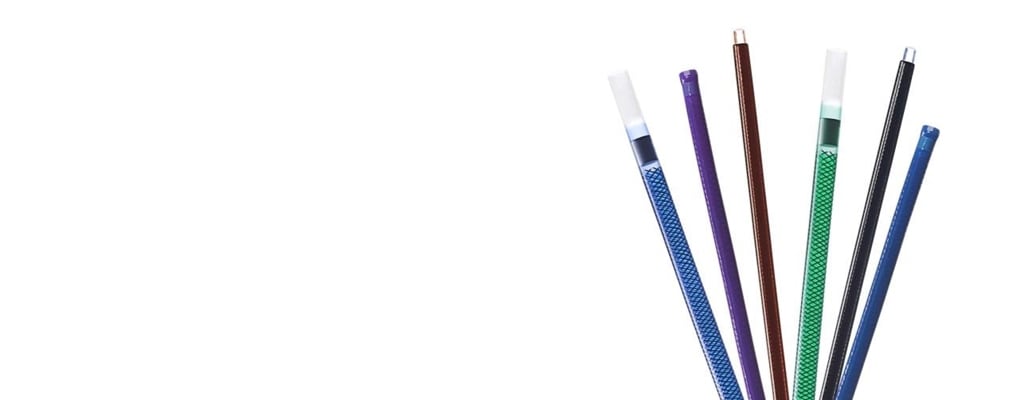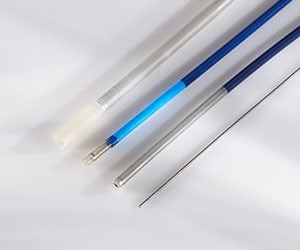
Braided & Coiled Catheter Shafts
Braided and coiled catheter shafts are two types of reinforced catheters designed to enhance their mechanical properties. Both include reinforcement layer - braided or coiled - into the wall of the catheter, but they differ in performance characteristics and design.
Collaborate with engineers who can bring your idea to life. We have deep braiding experience, leading technologies and global reach to support you in creating robust end-to-end catheter shafts. Our expert engineers use proprietary processes to provide thin-walled, braided and coiled catheters up to 30Fr size. We will work with you to find the right balance between column strength, flexibility, kink resistance and torque response in the thinnest wall possible to meet your performance requirements.
Configurations
Configurations
| Description | |
|---|---|
| Braided shafts | Polymer shafts with braid reinforcement. Braiding configuration (wire size and shape, number of wires, pattern and pitch) designed to suit the required shaft pressure, profile, steerability, flexibility, pushability and torque transfer. These are designed to suit the specific anatomy of the vessel the device is intended to navigate. |
| Coiled shafts | Polymer shafts with coil reinforcement. Coiled shafts have a high resistance to kinking, while remaining flexible for navigating tortuous anatomy. Coiling configuration (wire material, size, shape, diameter, pitch and stiffness) is designed to suit the required kink resistance, flexibility and pushability and torque transfer. |
| Multi-lumen shafts | Engineered shafts with multiple internal channels to accommodate guidewires, control wires, imaging / signal. |
| Multi-durometer shafts | Catheter shafts designed with jacket material of altering durometer along the length of the shaft to provide more flexibility in some sections and more stiffness and pushability in other sections. |
| Braid to coil transitions | Engineered shafts with braided and coiled reinforcement along a single shaft to give the required performance characteristics at each section of the shaft. |
| Varying pitch coils and varying pick count braids | Coil pitch is the distance between coil winds on a coiled shaft. Varying pitch impacts the performance characteristics such as flexibility, torque transfer and burst strength.Pick count is the number of wire cross-overs along an inch of braided shaft. Varying the pick count impacts the performance characteristics such as flexibility, pushability, burst resistance. |
| Deflectable and fixed curve shafts | Deflectable shafts can be deflected in a single direction using a pull wire and pull ring configuration. Fixed curve shafts are shaped with a fixed curve to improve the ease of access to the required part of anatomy. |
Specifications
Specifications
- Braid – OD from 2F to 26F, single wall thickness down to 0.005 in/0.13 mm
- Coil – OD from 1.5F to 28F, single wall thickness down to 0.003 in/0.08 mm
- Outer Jacket – polyamide, polyether block amide (PEBA) & urethane, custom blends
- Wire:
- Flat, round and ribbon
- Nitinol, stainless steel, aramid and fabric
- Wire diameters from 0.0005” to 0.010”
- Liners:
- Fluoropolymer: FEP, eFEP, eTEP, PVDF, PFA custom liners
- Thermoplastic: polyamide, PEBA, PU, PE
- Others: polyimide, PEEK
- Marker Bands – platinum, gold, radiopaque polymers
- Secondary Operations – bonding, porting, tapering, funneling, curving and tipping


Capabilities
Capabilities Overview
| Capabilities | Description (what & how) |
|---|---|
| Liner Stretching | Stretch PTFE liner on mandrel |
| Braiding/Coiling | Braid over mandrel or over lumen; precision needed for torquibility and kink resistance |
| Annealing/Termination | Heat treatment and braid wire termination to ensure smooth transition and no exposure or unravelling of braid wire. |
| Mandrel Pulling |
Removal of the support mandrel used to manufacture the product at the end of the manufacturing process. |
| Extrusions | Thermoplastic, heat shrink, PTFE (Learn more) |
| Cut to Length |
Ensuring smooth and clean cuts with good surface finish. |
| Assembly | Assembly of liner jackets or metal consent |
| Reflow/Bonding | Fusing of liner jackets through ovens and bonding of pull wires mandrels |
| RF Tipping | Radio Frequency (RF) technology for formation of atraumatic distal tips. |
| Drilling, Punching, and Skiving | Mechanical processes for component and device manufacture. |
| Inspection and Testing | Final inspection outside; borescope inspection and testing |
| Packing and Labeling | Packaging and labelling processes for bulk non-sterile and sterile finished goods in compliance with industry standards |
| Simulation | Structural, flow, thermal, mold flow, light / optics, additive manufacturing and extrusion simulations. |
| Wire-based (coax, electrical) | Cable designs that enable high speed transmission of imaging data, while incorporating various functionalities such as illumination and electrical transmission into a flexible and reliable product component (Learn more) |
| Fine Wire Termination | Integrating copper and fiber connectivity into our cables, producing highly flexible, yet rugged cables for the operating room. (Learn more) |
| Sterilization | Sterilization processing and validation supported with our external vendors. |
 e
e
 e
e
 e
e
 e
e
